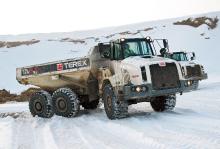The Mine Health and Safety Administration has released best practice guidelines to prevent cold stress for those working in cold environments with low temperatures high wind speed, humidity, and/or contact with cold water or surfaces. The condition can lead to death, permanent tissue damage or serious cold-related illnesses.
Best Practices:
- Monitor your physical condition and that of your co-workers.
- Wear several layers of clothing for insulation. The first layer should fit snugly against the skin and be made of a nonabsorbent material that wicks away water and keeps skin dry. Clothing should not be too tight as this may restrict movement resulting in a hazardous situation.
- Protect your ears, face, hands and feet in extremely cold or wet weather.
- Wear waterproof and insulated boots and clothing.
- Wear a hat to reduce the loss of body heat from your head.
- Have extra socks, gloves, hats, jacket, blankets, and a change of clothes available in case the weather becomes much worse or your clothes become wet.
- Use radiant heaters in break areas and limit the amount of time outside.
- Carry or make available a thermos of hot liquid.
- Include chemical hot packs in your first aid kit.
- Avoid touching cold metal surfaces with bare skin.
- Maintain adequate hydration and nutritional requirements.




